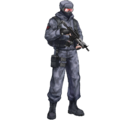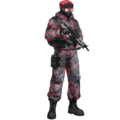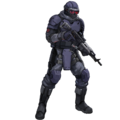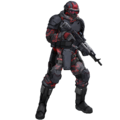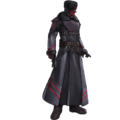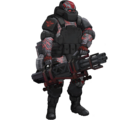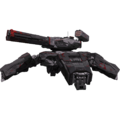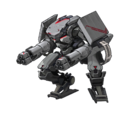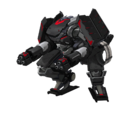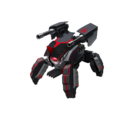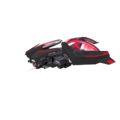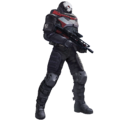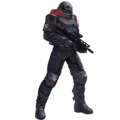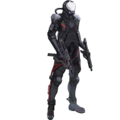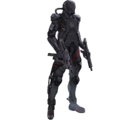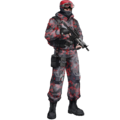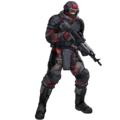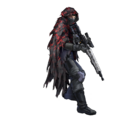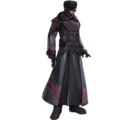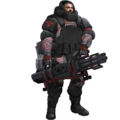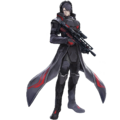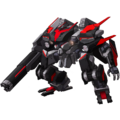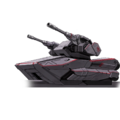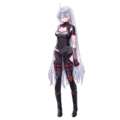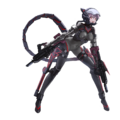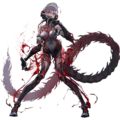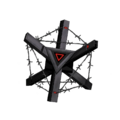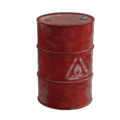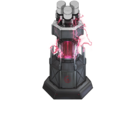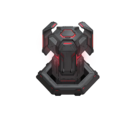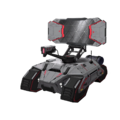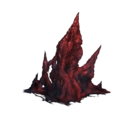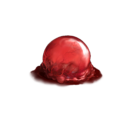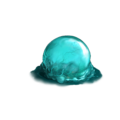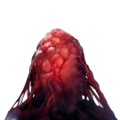Reverse Collapse Enemies
Enemies in Reverse Collapse: Code Name Bakery belong to the URNC, the Shrike consciousness or ELIDs. Certain levels will have two enemy factions at once. Enemies do not grant EXP, but the ones with an orange cube atop their head carry one or more drops, which may be items, crafting materials or weapon accessories.
The color and icon of the diamond atop enemies indicate their behavior: grey denotes a standby unit that will not move until it detects an enemy; orange denotes a unit moving toward a search area or following a predefined route (selecting the enemy will show their path or search area); blue denotes a defense stance, where the enemy will remain stationary but attack when an ally unit enters their range; red denotes an attack stance where the enemy will move into range of its priority target and attack. If the border of the diamond is flashing red, the enemy is ready to use a skill.
Like player units, enemy units are categorized as human, Shrike or machine, which determines the affinity of items towards them. The majority of enemies cannot deal critical hits. By default, during their turn, enemies move towards their target (a player unit or a player structure), then attack and use a skill, then stay in place as their turn ends. Some enemies can have bonus actions. When they have multiple targets available, normal enemies choose the closest one, while bosses usually target player units they can deal a killing blow to first, and failing that choose their target based on a specific stat (target priority can be seen in the Battlefield Information menu of the pause screen).
For information about enemies in 2092R mode, see Reverse Collapse Enemies/2092R.
Standard enemies
URNC
Scout
The most basic enemy, wielding an AT-77U rifle.
Their performance in combat is balanced between attack, defense, mobility, range and accuracy. Their only special trait is their above-average detection range, which makes them threats during stealth missions.
Elite Scouts, aside from better stats, have the Danger Awareness trait, which grants them one stack of Dodge once per turn, making them immune to the first normal attack they receive. This skill does not shield them from items.
Commando
A highly mobile soldier wielding an AT-77 rifle.
They are essentially the better version of the Scout, especially in terms of mobility, with the exception of their low detection range during stealth missions.
Elite Commandos have the trait Heroic Charge, which guarantees triple damage for normal attacks as long as they have 70% or more of their total HP. Without this trait, they cannot deal critical hits.
Sniper
A long-range soldier using an SVP-79 rifle.
They have superior attack, range and accuracy and can pierce armor, but in exchange are very squishy and not very mobile. Surprisingly, their detection range is as terrible as the Commando's.
Elite Snipers are even more dangerous and possess the Tactical Maneuver skill, which lets them move again after attacking.
Medic
Female soldiers equipped with MPN-6 guns, prioritizing healing their most injured ally or attack the closest enemy if there is no one to heal. The general rule of role-playing games applies: always take out the healers first.
Medics have flimsy stats overall and are not a real threat when attacking of during stealth missions. Their role is to use their skill Battlefield Treatment, which restores 580% of the Medic's attack stat as HP to one enemy target, usable up to tiles away and once per turn during the enemy's turn.
Elite Medics have better survivability, a boosted Battlefield Treatment skill healing for 900% of their attack, and most importantly have the Healing Factor trait which lets them heal both human and mechanical units for 300% of the Elite Medic's attack if they are injured within 4 tiles of them, negating of severely reducing the effects of traps and attacks that are not a one-hit kill.
Commander
Support units armed with a PLN handgun
As support units, their attack power is unremarkable but they have good survivability and anti-stealth vision, and their trait Field Commander increases the evasion of their allies within 4 tiles by 40.
Elite Commanders have a number of differences: their Field Commander trait not only increases the evasion of allied units by 50, but also increases their accuracy by 15 within 5 tiles, and they will seek to maximize this effect by moving to the biggest concentrations of allies before choosing the closest target to attack. Their extra trait Target Analysis will reduce the crit rate of 2 random human player units within 15 tiles by 40% at the end of the enemy turn. Their skill Assault Command increases the attack of one of their units up to 5 tiles away by 30%, their accuracy by 30 and their evasion by 30 for 2 turns. They also have 100% chance to inflict 3.2× damage with their normal attacks, which also make them actual threats of their own.
Machine Gunner
Heavy soldiers wielding a KG-11 machine gun.
As expected from their appearance, these enemies are slow but hit hard and are tough to take down. They have lots of HP and armor-piercing capabilities, but abysmal anti-stealth vision. Their base attack stat is on the lower side, but this is because they have the Rapid Fire trait which lets them perform 5 consecutive hits on the same target during their normal attack.
Elite Machine Gunners are even tougher and have the extra Devastating Strike trait, which inflicts the Untreatable trait on their target, preventing them from recovering HP for 1 turn.
Svarog
The first machine unit fought by the player in the Prologue of Chapter 3 is the intimidating tank that kills Lige at the start of every timeline.
Aside from their high amount of HP, Svarogs have two stacks of force field which are only reliably taken down by rocket launchers, and a lot of armor points. Melt Bombs and armor-piercing items, weapons and skills are a must-use, such as the RC Bomb, EMP Mine, Mendo's Viper, Atena's Oryx, Jefuty's Petrel and Critical Armor Break, and Jevon's Meteor, Raging Flame or Last-Ditch Gambit or a Heavy Turret (or just use a Cruise Missile if you're flush with resources.) They also have a lot of attack points, very high accuracy and armor-piercing capabilities. They are also a threat during stealth levels due to their wide detection area.
Aside from their normal attack, Svarogs use the High-Explosive Missile trait to launch missiles at a priority target within 20 tiles during their turn, striking a cross-shaped area at the end of the player's turn to deal 110% of the Svarog's attack. Their real killer move however is their Laser Main Cannon skill, which deals 125% of their attack to enemies within a 2 by 6 area directly adjacent to the tank. This attack has a 3 turns cooldown and uses 60 energy points, of which Svarogs recover 20 at the end of their turn. The Energy Drainer is there to limit their attack capacity if one of your units is in range of this skill.
The trait Low Altitude Hover negates the extra movement costs of special tiles and enable Svarogs to move for a flat 1 AP per tile. However, they don't actually fly and are also two tiles wide, which means that they can't get past small paths. The upgraded EMP Grenade will also stop their movement.
There is an elite version of the Svarog called the Khors, which appears in Chapter 4, Mutual Destruction. These metal monsters have four stacks of force field which they can regenerate at a rate of one per turn on top of overall better stats, and a target-tracking Guided Missile. But their Laser Main Cannon skill is only used to damage the mountain every two turns in this mission.
AA-03
Bipedal Assault Artillery mechs armed with two “ELID Dominator” machine guns.
These mechs have attack and armor piercing stats comparable to the Svarog's, but less armored and without the problematic arsenal of the tank. They are quite mobile however, and their Sweeping Shot trait will cause allied units adjacent to their target to take 30% of the attack's damage.
The elite version of the AA-03 is the AA-03-B4M Autonomous Mech, which on top of overall better stats uses the Firepower Suppression skill to deal an armor-ignoring attack with the extra effect to prevent a human target within 4 tiles from moving on the next turn. This skill doesn't use energy but has a 2-turns cooldown.
Simargl
A four-legged "Autonomous Tracker" that looks like a very angry Dinergate.
The two lightweight double-barreled machine guns on their back are used to cause moderate damage within 2 tiles, but the real threat is their close-quarters skill Shattered Slash, which deals 340% of their attack with 45 armor penetration and also destroys 1 stack of force field. Simargls tend to move in packs, which makes this skill very dangerous even for tough targets.
However, Simargls are also pretty flimsy despite their 15 armor points, and mostly rely on their somewhat high evasion to survive. They can be dealt with swiftly using area attacks.
The elite version of the Simargl is the Porevit, an overall improved version that is a bit more difficult to destroy and have the enhanced Piercing Fangrip avility, which lets them charge through 3 tiles in a straight line, dealing 310% damage to the first tile, 140% to the second and 70% to the third with 70 armor penetration, while taking down 2 force field stacks.
Marzanna
These UAVs have the unique ability to disregard the terrain and move at a cost of 1 AP per tile. Combined with their large 6-tiles detection range, they are the perfect scouting drone.
On top of this mobility, Marzannas can be annoying to hit due to their high evasion and small armor and come with two more annoying utilities: the Minesweeper trait destroys ally trip mines, tracking mines and RC bombs within 2 tiles of the Marzanna, and the Hindering Strike skill deals 90% of their flimsy attack but also displaces the target by 1 tile and increases movement cost by 1 AP for the next turn. With these abilities, Marzannas can both ruin perfectly good ambushes and expose a protected unit to lethal hits.
The Filins is the upgraded version of the Marzanna. Its stats, including detection range, are improved and its skill inflicts 110% damage instead of 90%.
Devana
This "lightning cannon" is a fixed structure dedicated to area defense.
When there are no target within its range, the Devana is in defense mode and reduces all incoming damage by 90%, on top of its sizeable amount of armor. Once an enemy enters its attack range, it leaves defense mode and will be primed to use its laser cannon to make a rotating attack within its detection range. When attacked while not in defense mode, the Devana will automatically retaliate. Leaving a unit in the range of a Devana during enemy turn is a bad idea due to its high attack power, unless its energy points are drained under 30 points, the minimum it needs to use its Energy Blast skill, but this will costs a lot of resources since the Devana will recover 20 energy points at the end of its turn.
The key to destroying a Devana is to exploit the difference in its rotating attacks: during enemy turn, the Devana's skill will cover all tiles around it, but its defensive attack during the player's turn only rotates 90°, leaving two quadrants around it safe to step in. Observe the position of the laser cannons and keep in mind that the attack always rotates to the clockwise.
Special Forces - Skull
Members of the Werewolves Commandos wearing heavy armors and an SDS rifle.
These bulky units deal a fair amount of armor-piercing damage, have good detection range and start their turn with two stacks of Counterattack, which lets them retaliate against any attack during the player's turn as long as the attacker is within their own attack range of 5 tiles. Their Pain Dispersion trait allows them to reduce damage from area attacks by 40%, and they gain a refractive camouflage at the start of their turn which makes them invisible outside of detection range.
The retaliation trait can be countered with the Analyzed status of the Flashbang, while their camouflage can be countered with scanners or the Spotted status of the Stun Grenade.
The Elite Special Force - Nightmare is the enhanced version of the Skull. Their main difference is the Silent Strike skill, usable every two turns, dealing 130% of their base attack while inflicting Disoriented to human targets for 1 turn, preventing the use of skills.
Special Forces - Cyclone
Agile members of the Werewolves Commandos wearing two PPC-86 submachine guns.
These units are built on the evasion and accuracy stats: they have naturally high evasion, their trait Fleet Footwork halves the accuracy of their attackers, and their Diversionary Shot trait reduces the evasion of the target of normal attacks by 20 for 1 turn. Like the Skull, they also gain a refractive camouflage at the start of their turn.
The Elite Special Force - Thunder is the enhanced version of the Cyclone. Their Diversionary Shot trait is enhanced to reduce the crit damage of the target by 80% on top of the base evasion reduction, and their skill Precision Strike deals 120% damage while inflicting Disarmed, disabling normal attacks for the target.
Shrikes
Shrike Mitotic Specimen
Starting with Chapter 3, Act 2, the Lige boss you encountered in Chapter 2, Act 7 will become regular elite enemies. Thankfully, you're no longer as underprepared as during the boss version: you have Blood Bullets now.
Like Lige, the mitotic specimens are very mobile, have a large detection range, only attack in close-quarters, and will prioritize attacking Jefuty, then any player unit they can kill in one attack, then the player unit with the highest attack. Their skills include Phantom Blade, a teleportation up to 4 tiles away followed by a 1-tile area attack, and Crippling Dash, a dash towards an enemy target with a 1 turn charge dealing a guaranteed one-hit kill on up to 2 units on the way (the dash will track the target and the mitotic specimen can act after the dash). Both skills have 3 turns of cooldown.
Traits include the ability to pass through enemies to grant better mobility, 25% of the target's Max HP on top of the flimsy damage from normal attacks, conversion of damages into HP when attacking, a damage boost when an enemy with more than a certain percentage of its HP is within 7 tiles and immunity to all abnormal statuses... with the exception of Impure Blood and Reverse Blood.
Impure Blood is inflicted by Blood Bullets and Blood Grenades, and Reverse Blood by Blood Grenades only. The first effect nullifies the mitotic specimens' Psychic Awareness invincibility trait, while the second enhances damages against the mitotic specimen.
In Honeypot, the mitotic specimens will also have the ability to attack three times per turn and the skill Fusion, which lets them absorb another specimen that has been defeated to recover all of their HP and receives a stats boost.
During the levels Blood Horror and Nightmare in Chapter 4, special versions of the Shrike mitotic specimens called Shrike Consciousness will appear. These enemies function with special rules.
Shrike versions
During certain missions where Shrike β or Sugar are present, Shrike versions of the basic URNC units can appear as resurrected corpses. As a generality, these units are less mobile, but are more difficult to kill than their original versions due to a 50% damage reduction trait and immune to most statuses. They also explode on death, causing a punishing amount of armor-piercing damage 2 tiles away.
Blood Bullets are not only extremely effective against these Shrike units, but nullify the effects of their explosion, and Blood Grenades will reduce their resistance.
In Chapter 3, Act 8, not only URNC forces, but also resurrected allied TASA soldiers can be fought, along with the resurrected corpses of Carl, Jevon and Atena, who will retain one of their skills. Depending on your performance in Chapter 4, The Final Battle II, you may have the displeasure to meet these three unique enemies again. Your former allies will additionally leave Crimson Blisters on death, the explosions of which has similar effects to a Blood Grenade. Carl, Jevon and Atena will also leave Deep Blue Blisters weakening the attack of Shrikes.
Illusion versions
Scouts, AA-03s and Svarogs can appear as illusion versions during Chapter 4, Blood Horror and Nightmare. These versions must be killed with the special tools provided in these levels.
ELIDs
Transmogrified Infected Individual
You're not meant to fight these by normal means.
The torn remains of clothes and a gas mask betray what this creature once was. Very mobile and attacking the closest enemy at close range with its claws, it hits hard and doesn't goes down easily due to its armor, but it's complete blindness makes it easier to sneak by it during stealth levels.
The Low-Frequency Acoustic Generator is meant to lure these away during stealth levels, while the High-Frequency Sonic Bomb is meant to push them toward other enemies. If they really need to be fought, rocket launchers and blood weapons will work.
Terminally Infected Individual
You're not meant to fight these by normal means.
These are less mobile than the transmogrified ELIDs, but also have more armor and attack, and can strike three tiles away by chucking boulders. Strategies to deal with them remain the same as the transmogrified.
Bosses
Aye and Ivor
Two Elite Scouts fought in Chapter 2, Act 2. If there is no sure-kill target in range, they target the player unit with the lowest evasion.
Both bosses have a different extra skill: Aye's Enhanced Stun Grenade reduces evasion by 30 and increases damage taken by 15% in a 3-tiles radius up to 5 tiles away, Ivor's Anti-Personnel Grenade deals 50 damage to enemies within a 2 tiles radius up to 3 tiles away.
-
In the demo, Ivor was an Elite Commando instead.
Mach
An Elite Sniper fought in Chapter 2, Act 4. If there is no sure-kill target in range, he prioritizes targets the highest attack. He has an extra trait called Bullet Menace, which reduces the APs of player units when another player unit is defeated within 3 tiles of them.
Gregory
An Elite Commander fought in Chapter 3, Act 4. He first prioritizes maximizing the efficiency of his buffs, then targets a sure-kill player unit, then the one with lowest evasion.
He has an extra trait granting him immunity to Scorched, Exhaustion and Bleeding and the extra skill Formation Break, which doubles damage taken by player units in a 3 tiles radius up to 15 tiles away for 2 turns.s
Gouo
An Elite Machine Gunner fought in Chapter 4, Preemptive Strike. If there is no sure-kill target in range, he choose the target with lowest evasion. He is immune to the Scorched, Exhaustion and Bleeding status, and his extra skill Ruthless Banner boosts the crit rate of his allies within 5 tiles by 30%.
Tangieu
An Elite Special Forces - Nightmare that must be killed during Chapter 4, No Escape. If there is no sure-kill target in range, he prioritizes targets with lowest evasion. He is immune to the Scorched, Exhaustion and Bleeding status, and replaces the usual Silent Strike skill with Suffocating Fumes, which creates a 2-turns fog in a 2-tiles radius up to 6 tiles away reducing accuracy by 15 and inflicting 20% of Max HP as damage at the end of an action.
Xion
An Elite Special Forces - Thunder fought at the end of Chapter 4, Enticement. The main difference with normal Thunders is his Extreme Speed trait, which gives him an extra movement and attack phase.
Thian
Captain Thian, nicknamed “the Bloody Angel”, is an Elite Medic fought in Chapter 4, Dead End. She prioritizes healing the most badly wounded ally, then targets a player's unit she can kill in one hit, then the closest one.
On top of boosted survivability, she is immune to the Scorched, Exhaustion and Bleeding status, and has two exclusive skills: Bloody Angel is an upgraded version of the base Battlefield Treatment skill, healing 980% of her attack while also increasing Max HP by half, while Guardian Reagent has an area-of-healing restoring 300% of her attack in HP within 4 tiles around her.
Eugene and Break
A duo of one Elite Special Force - Nightmare and one Elite Special Force - Thunder fought in Chapter 4, Mutual Destruction.
Aside from their overall better stats than the already sizeable board of the Nightmares and Thunders, they are also immune to Scorched, Exhaustion and Bleeding and have the unique Linked Operation trait, which makes both of them immune to attributes decrease while the other is on the map. Eugene also has a 20% chance to inflict 3.25× damage, while Break has a 16% chance to deal 3.65% damage.
Aengus
An Elite Special Forces - Thunder arriving when you near the objective in Chapter 4, Rapid Advance, targeting a sure-kill player unit, then the one with highest SP. He is immune to Scorched, Exhaustion and Bleeding and replaces his Precision Strike skill with Armed Intervention, which does not deal damage but applies the Disarmed effect preventing the use of normal attacks to a 3 tiles radius up to 4 tiles away.
AA-03-B4W
A special Assault Artillery automech appearing in Chapter 4, Treacherous Road. It is said to have been transferred from the Asian Theater and to be invincible. It looks exactly like a B4M.
Its stats are noticeably higher than other AA-03-B4Ms, and it even has a 5% chance to deal triple damage. Also unusual are the two stacks of force fields and Advantageous Strike trait allowing normal attacks to hit twice.
Super Mutant Lambda
A truly terrifying creature appearing in Chapter 3, Act 3 and Chapter 4, Zombieland and Escape. The skulls of multiple creatures can be seen protruding from its head.
Unlike other ELID units, this one can hear you from six tiles away and its HP, attack and armor stats are through the roof. Its Avenger trait increases the attack of all ELIDs on the map by 30% when it sustains damage, and its Ground Shatter skill deals 80% of its attack in a 3 tiles radius.
In Chapter 3, the Lambda will be an unstoppable force, but in Chapter 4 the presence of Shrike Mitotic Specimens able to deal guaranteed instakills will make him more of a stoppable force.
Oleg
AAX-05S
A unique mech piloted by Oleg, fought in Chapter 4, The Final Battle I.
Its stats are the highest of the bipedal mechs, it has 20% chance to deal 3× damage and its normal attacks hit twice for all units adjacent to its target. Its skill deals a flat 100 damage on a 3-tiles area up to 6 tiles away with 2 turns cooldown. If there is no sure-kill target in range, he will choose the one with the highest SP.
Kirill
Jarilo
A rail-mounted combat train first fought in Chapter 3, Act 7.
Two Jarilos assist the Diberg mobile fortress. Their main feature is their Tracking Shot trait, which attacks any player units that stops or takes an action other than passing through within their 7 tiles firing range, effectively interdicting large swathes of map terrain. This trait uses 5 energy point per shot, and so can be countered with energy drainers (Jarilos replenish 25 energy points at the end of their turn). On their own turn, they will target any player unit they can kill first, then the one with the highest attack. If possible, they will use their Crushing Collision trait, which deals flat 220 damage to and displaces units that are on their rail when they move along it, though they have limited mobility due to their low amount of AP.
Jarilos reappear in Chapter 4, Lure the Enemy, but they are not at max HP, and in Chapter 4, The Final Battle I, the player con control two of them.
Diberg
A rail-mounted battle fortress first fought in Chapter 3, Act 7.
With high HP, two stacks of force field and beefy armor, it's a slow grind to take it down, even with the newly acquired anti-mechs items and Jefuty's armor-piercing Petrel rifle. The Diberg has the same Crushing Collision trait as the Jarilos, dealing 300 damage to and displacing units on its movement path, and even has 10% chance to deal 2.5× damage.
If there is no sure-kill target in range, he Diberg attacks the player unit with the lowest HP first. Aside from its Smasher HMGs that can fire up to 7 tiles away, the Diberg uses its Incendiary Missile skill to deal 60 damage in a 2-tiles radius within 20 tiles, while also applying the Scorched status that consumes 20% of the target's Max HP at the end of the player's turn, and leaves a patch of burning ground for 1 turn. Unlike the Svarog's High-Explosive Missile, this attack lands on the same turn. The Diberg's most deadly attack is the Daybreak skill, a 2×10 tiles laser dealing 160% of the Diberg's attack. Its main limitations are its directionality, as the Diberg can only fire at 90-degrees angles, and its energy cost, draining 60 points out of the maximum of 100. The Diberg recovers 30 energy points at the end of its turn.
The Diberg reappears in Chapter 4, Lure the Enemy, but it won't be at max HP. It also appears without its usual two Diberg helpers during Chapter 4, Mutual Destruction, where it will be the main threat to the integrity if the mountain where the map takes place. In Chapter 4, The Final Battle I, the player can control this metal monster for themselves starting turn 5.
Lige? (Chapter 2)
The first fight against “Lige?” takes place under the watchful eyes of Sugar in a field of Epiphyllum during Chapter 2, Act 7. Blood items are not available yet, so players must use incendiary grenades and the terrain to take her down.
Lige? is very mobile and attacks in close-quarters. She always prioritize Jefuty, then any player unit she can kill in one attack, then the player unit with the highest attack. Her traits include the ability to pass through enemies, damage her targets for 25% of their Max HP on top of the flimsy damage from normal attacks, 70% conversion of damage dealt into HP, the ability to attack three times per turn unless she stops on an Epiphyllum tile, and immunity to all abnormal statuses except Radiation Overdose.
Radiation Overdose is inflicted by burning an Epiphyllum tile where Lige? is standing, and nullifies the Psychic Awareness trait making her invincible. Controlling Lige?'s movement so she stops on Epiphyllum tiles is the key to this fight, though she will always avoid this condition if possible. After getting down one time, Lige? gets a second wind and unlocks the Lethal Dash skill, where she targets her priority unit, preventing it from taking any action, before dashing toward it after one turn. During the dash, Lige? can inflict two one-hit guaranteed kills, which means that if two targets are put in her path and sacrificed, the final target will be spared.
Later, Shrike Mitotic Specimens are versions of this boss that are regularly encountered, but Blood Bullets and Blood Grenades make fighting them much easier. Though it is not indicated on her character details, Lige? is vulnerable to the Impure Blood and Reverse Blood statuses like any Shrike unit.
Lige (Chapter 4)
There are two other versions of Lige fought during Chapter 4:
- During Panicked Battle, Escape and Midnight Stratagem, her abilities are the same as during Chapter 3, but she has a lot more HP to compensate for your access to Blood items.
- During Honeypot, Lige has the same traits as before and these two skills: Phantom Blade, a teleportation up to 5 tiles away followed by a 2-tiles radius area attack for 120% damage, and a map-wide version of Lethal Dash (meaning that she can target Jefuty from the other side of the level as long as another enemy unit has spotted her). Both skills have 3 turns of cooldown.
-
In Panicked Battle and Escape (uses Bone Blades).
-
In Honeypot and Midnight Stratagem (uses Blood Thorns).
Shrike β
This corrupted version of Lige first appears in Chapter 3, Act 8 and is then fought throughout Chapter 4.
The only remarkable stat of Beta is her huge HP pool, most of the danger comes from the nuisance potential of her traits and skill. Every three turn, she will resurrect 4 URNC soldiers, who will spawn on the field as Shrike variants one turn later (depending on the level, other types of units might be resurrected at scripted points). Her skill Sharp Thorn summons a Blood Thorn up to 2 tiles away, harming and displacing the target (or if the target is an equipment, instakilling it). At the end of each enemy turn, she will increase the attack of player units by 8 and reduce their accuracy and evasion by 3.
Unlike other Shrike bosses, Beta is only susceptible to the Reverse Blood damage-multiplying status of Blood Grenades, and not to the Impure Blood status of Blood Bullets.
Sugar
Sugar Σ
Structures
Barricade
Czech hedgehogs with barbed wire, your enemy's equivalent of your Barbed Wire Barricade. Fairly sturdy due to its 10 armor points, but usually not placed in locations that make them actual problems.
Oil Drum
You probably already know what a red barrel does in video games.
These fragile explosive containers deal 180 damage exclusively to enemy units, never to player units, in a 2-tiles radius. An upgrade to the Incendiary Grenade make their explosion even more dangerous.
Energy Charger and Defense Installation
Usually deployed when the Diberg mobile fortress is on the map. The former grants 20 energy points to all mechanized enemies on the map at the end of the turn, and the latter reduces damage by 30% to all enemies within 15 tiles.
Wide Area Electronic Jammer
Encountered in Chapter 4, Treacherous Road, these armored structures incapacitate any equipment deployed by the player and increase the AP costs of using items by 1 in 15 tiles around them.
Blood Thorn
Spawned by Shrike β, Sugar Σ and Blood Palms, these fragile structures behave like normal Shrike units, causing a Blood Burst on death to deal a punishing amount of damage (and leave Blood Mist in certain levels). Because they can be destroyed by the explosion of nearby Shrikes, and can trigger traps, they are susceptible to cause dangerous explosion chains.
Crimson Blister
Spawns around the corpse of the Shrike versions of TASA Soldiers, Atena, Carl and Jevon (due to Residual Consciousness and Remnant Will traits). On destruction, deals crippling damage to enemies within 2 tiles (cannot harm player units) and applies Reverse Blood to Shrikes within 5 tiles for 1 turn (can be stacked).
Deep Blue Blister
Spawns around the corpse of the Shrike versions of Atena, Carl and Jevon (due to Remnant Will trait). On destruction, reduce attack by 60% to Shrike units within 5 tiles for 1 turn.
Blood Palm
Encountered in Chapter 4, The Final Battle II. These heavily armored Shrike structures attack with Blood Thorns within 4 tiles around them and spawn 4 Blood Fruits whenever there are empty tiles directly adjacent to them. Like all Shrike units, they also cause a punishing amount of damage when defeated, while also leaving a wide area of Blood Mist.
Blood Fruit
Encountered in Chapter 4, The Final Battle II, they are spawned around Blood Palms and four of them at random will mature into Shrike units each turn due to the Sanguine Pulse trait of Sugar Σ. Like all Shrike units, they create an explosion when defeated.
Blood Cocoon
Encountered in Chapter 4, The Final Battle II, it replaces the player unit targeted by Sugar Sigma's Assimilation trait and must be destroyed to free it. The cocoon is somewhat sturdy and leaves a Blood Mist tile that immediately affects the freed unit, unless the cocoon was broken with a Blood Bullet.
| Reverse Collapse: Code Name Bakery |
|---|
|


